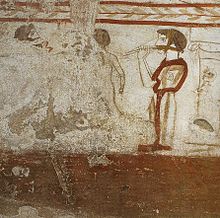Phorbeia
The Phorbeia was an aid that musicians used in ancient times . Mainly it was used by aulosplayers , but there are also testimonials that prove its use in combination with a Salpinx .
description
The Phorbeia, called capistrum in Latin , apparently consisted of leather straps that were wrapped around the musician's head. One of them framed the face, so to speak, by being led vertically upwards under the lower jaw and on the sides of the face in front of the ears. At the level of the cheeks it crossed with a second ribbon that was placed horizontally around the head. The top of this second band was below the nose. It may have covered the mouth and only had recesses for the wind instruments.
The Phorbeia has been handed down in this form on numerous ancient works of art; the oldest known representation dates from around 700 BC. It is an orthostat relief (NVI 7) from Karatepe , which suggests that the Phorbeia originally came from the Orient . Almost all of the illustrations show the use of the Phorbeia by men who probably appeared as professional musicians at competitions, ritual events or in military contexts. There is evidence of its use in combination with a Salpinx dating back to around 480 BC. Chr .; the use of aulos and tibia players has been proven until the Roman Empire .
Text testimonies to Phorbeia are less common than figurative ones. The Greek-English Lexicon by Liddell / Scott / Jones lists three passages in the text for the use of the word φορβειά: Aristophanes , The Wasps 582, Plutarch 2, 456b and Sophocles , fragment 768. The explanation is added that “to play without Phorbeia” like this much means like "playing too loud".
function

How and for what exactly the Phorbeia was used is controversial. There are several theories:
The Phorbeia could e.g. B. have been used to support the cheek muscles and suppress the ugly bloating of the cheeks.
The Phorbeia could also have served to support the lip muscles and to optimize the blowing of the two tubes. Then she would have B. prevents the escape of air next to the mouthpieces.
Another theory based on physiological considerations was to get a better and longer tone by using the Phorbeia, which is said to have regulated the exhalation.
According to another theory, the Phorbeia was used to give the instrument support on the body of the musician, so that he had to use his hands mainly for gripping.
Helmut Brand considers at least the aesthetic aspect to be insignificant, since wearing the Phorbeia disfigured the musician as well as inflated cheeks. He explains the theories, according to which it was about "saving" air and better sound quality, to be more plausible and connects the Phorbeia with the disc at the zurna , which is important for the circular breathing , which may also be used by ancient aulos players .
Bernard Andreae has a different opinion: “In order to be able to hold the tongue firmly between the lips and not have to inflate and strain the cheeks too much, the player wears a Phorbeia, a bandage that is placed around the cheeks and mouth and that is passed over the head Tape is held at the correct height. The tongue blade mouthpiece can be inserted into this through a lip slit while the cheek muscles are pressed together by the bandage. "
literature
- H. Becker: On the history of the development of ancient and medieval reed instruments (1966) 120–129.
- A. Bélis: La Phorbéia, in: Bulletin de correspondance hellénique 110, 1986, 205-218.
- Helmut Brand: Greek Musicians in Cult (2000) 117–118.
- Helmut Brand: Thoughts on the use of Phorbeia, in: Studies on Music Archeology Vol. 3 (2002) 375 ff.
Web links
Individual evidence
- ↑ This strap is not clearly recognizable under the chin on all images. In a picture from the Paestan grave of the black knight, for example, it seems to be missing.
- ^ A Greek-English Lexicon compiled by Henry George Liddell and Robert Scott , revised and augmented throughout by Sir Henry Stuart Jones . With a supplement, Oxford, Clarendon Press 1968, p. 1950, p. ???.
- ↑ Helmut Brand: The Phorbeia - an aid for ancient aulos players
- ↑ Bernard Andreae, grave of the deer hunt , in: Bernhard Andreae et al., Painting for eternity. The tombs of Paestum. Hirmer, Munich 2007, ISBN 978-3-7774-3745-3 , pp. 60-67, here p. 67.


